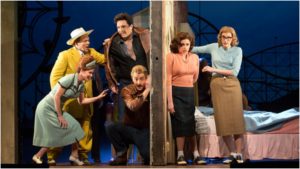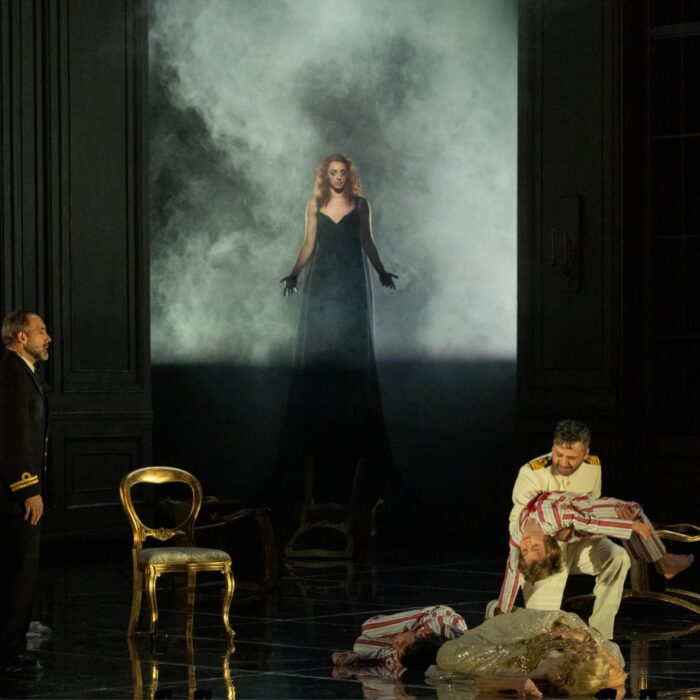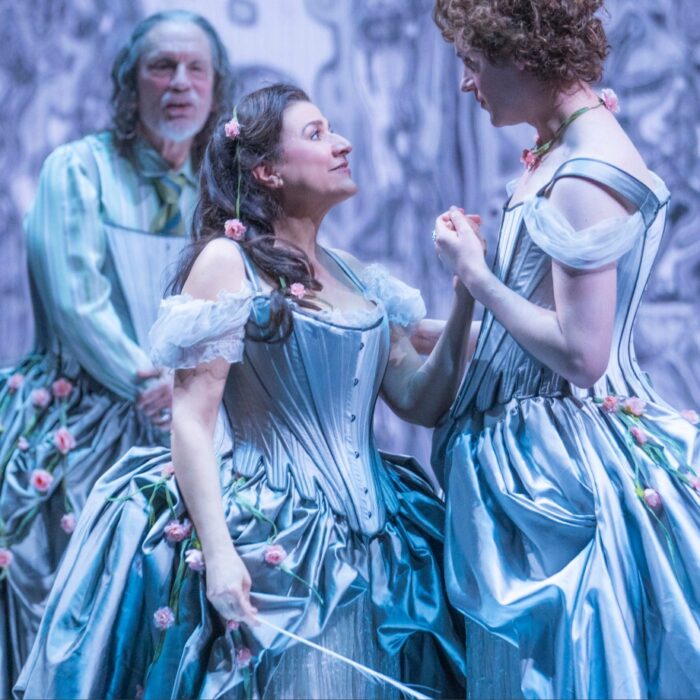
Metropolitan Opera 2017-18 Review – Così Fan Tutte: Kelli O’Hara, Christopher Maltman Lead Wonderful Cast in Fantastical Production
By David SalazarIt was intermission at the premiere of Phelim McDermott’s new Metropolitan Opera production of Mozart and Da Ponte’s “Così Fan Tutte” and someone made this statement to me.
“It’s fun and everything, but why set it on Coney Island?”
It’s a great point, but one could extrapolate that entire statement to the opera itself – “It’s got great music and funny moments, but why ‘Così Fan Tutte?”
Especially now.
Of the three DaPonte-Mozart works, this one is by far the biggest onion of them all. No one knows what to make of it, as pointed out rather jokingly by this production during its overture. A series of performers hold out cards with words on them. They arrange them to establish the opera as a sophisticated sex drama. But then they fumble around to create yet another meaning for the work, eliciting laughter from the audience. And the new version, which plays more on the opera being about gender politics isn’t all that wrong.
Whether it is a drama or a comedy, one can’t say. And what it is ultimately about? Well, that’s quite elusive as well, especially in today’s social milieu.
After all, this is an opera where the main plot features two women repeatedly tell two men that they want nothing to do with them, but find those desires ignored and disrespected. An opera in which the entire point is to prove that women, in matters of sex and love, are without integrity and faithfulness.
Again, why “Così Fan Tutte?” Coney Island or otherwise.
Coming into this production, and with everything surrounding its opening, one might find oneself thinking that this could be a major gimmick destined for epic failure.
The last production of the opera at the Metropolitan was conservative and safe – the gender politics kept clean and neat without the hint of sexual transgression this opera could potentially play up. That’s the benefits of setting something in the 1700s or 1800s. But 1950, on the cusp of the sexual revolution in the US?
Time to be careful. Throw in the fact that the star casting of the show could also backfire and this could have been a rather unforgettable night for the wrong reasons.
Well, it was an unforgettable night for all the right reasons.
Visually imposing and memorable production? Check.
Tasteful approach to the sexual politics in the opera? Check (the seduction of the women was done in more of a romantic style without crossing any line).
The Broadway star showing her vocal versatility in a major opera role? Double check.
Good singing? More like great singing!
Yes. McDermott’s “Così fan tutte” is a major success.
So, let’s unpack this.
A World of Mysticism and Magic
The production puts the spotlight on Don Alfonso. He’s the protagonist on a mission and every other character is either his ally or an antagonist to his ultimate motivation – to express that the world of love is a sham. Establishing the setting as the magical Coney Island, with its numerous illusions and ever-changing landscape is simply an externalization of this perspective. Nothing is stable. Nothing is truly real. Sure, the sword eaters swallow their blades and there is someone to spits out fire, but it’s all part of this fantastical world we don’t see every day. It’s hyper-romanticized to the point of exaggeration; just like love is in Alfonso’s mind.
The set is perfectly established, the motel (which serves as the home of the sisters) is wonderfully created to rotate in and out of rooms. This makes for some humorous transitions and really adds to the lack of intimacy among the characters. Set in a house, we get a sense of Fiordiligi and Dorabella’s domain and emotional stability. Having them stay in a motel completely underlines the point that they have no “true home,” and further supports Alfonso’s philosophical perspective on them.
We could go point by point on how everything works in this production, but the reality is, you need to experience it for yourself. All in all, it conjures up a sense of “Così Fan Tutte” as a moral fairytale in which love is the true fable of it all.
The Main Character on a Quest
As Don Alfonso, Christopher Maltman was a dominant presence. Wearing a bright mustard suit, it was impossible to miss him. He moved with ease and freedom that no other character on stage possessed, but it only accented the fact that HE is the main character in the opera. His singing furthered this point, Maltman possessing arguably the largest sound of the ensemble, and using it to his advantage at every moment. He relished recitatives, his sound carrying throughout the cavernous Met. This was particularly noticeable in his proclamations that “Così fan tutte” near the end of the opera. Moreover, he had a tremendous chemistry with Kelli O’Hara’s Despina, who (Spoiler Alert) was all too ready to reciprocate throughout the show and eventually did in opera’s final moments.
Four Different & Similar Lovers
The lovers were wonderfully cast for a number of different reasons – we went from opposites attracting to affinity among similarity. On one end of the spectrum was the pairing of Adam Plachetka’s thick baritone with Amanda Majeski’s slender and delicate soprano while on the other was the tender tenor of Ben Bliss and Serena Malfi’s meatier mezzo-soprano. When the couples switched up their games, their new pairings seemed like matches made in heaven. The duet between Guglielmo and Dorabella, while gentle, had passion and intensity at its core, the two earthier sounds melding excitedly. Meanwhile, Majeski and Bliss’ voices coalesced sublimely, relaxing the listener with their beautiful sounds.
Individually, each of these artists painted a complete portrait of these distinct characters. Plachetka’s Guglielmo was more fiery and excitable, most noticeably in the final act. His aria “Donne mie, le fate tanti,” was jovial, but had muscularity in its phrasing as he tried to prop up the pained Ferrando. Whereas Bliss’ Ferrando melted with sorrow at seeing himself betrayed, Plachetka was more feral in his discontent, especially during the “marriage” ensemble.
As noted, Bliss was the “softer” of the two characters, and this is borne out by his two main arias, “Un aura amorosa” and “Tradito, schernito.” In the former, Bliss was, well, blissful. His legato line was pristine and every sound that came out of his voice was suave and gentle. He caressed with every phrase, the higher notes coming off effortlessly. The latter aria had a bitterness in its coloring, yet he retained a restrained singing style , the accenting kept in check. You felt that Ferrando was, more than disappointed, deeply hurt and his singing had a pleading and weeping quality to it. In his scenes with Fiordiligi, the passion came from his sweetness.
As for the ladies, the contrasts arose from their degrees of assertiveness. Initially, Serena Malfi matched Majeski vocally in coloring and phrasing, exploring how close these two were; they were almost identical in their styles. But slowly and surely, the mezzo gave Dorabella a personality of her own. She became more playful, jumping on the bed, batting her eyelashes at Guglielmo, and then simply letting her voice soar with unbridled intensity whenever she got the moment to do so. By the time we got to the aria “E’amore un ladroncello,” she was taking in the limelight, wrapping herself with scarves and simply having a grand old time. Her voice was seductive in its brightness and elegance. During her scenes with Guglielmo, there was sassiness in her manner, which added to their sense of inevitable chemistry.
Majeski’s Fiordiligi, wearing glasses, immediately came off as timid. Unlike her sister, who slowly but surely imbued wildness of character, Majeski was more subdued and temperamental. Her first aria, “Come scoglio immoto resta,” which demands a wide range of emotions from the soprano was wonderfully executed technically, Majeski exploring Fiordiligi’s explosive temperament without moving too far out of character. Rather than a potent and assertive woman, she came off us a bit overwhelmed by the circumstances; this certainly matched the tone early on when the women were completely overpowered by the men. But she seemed to grow more and more assertive in her decisionmaking as the opera developed. Even though the character herself has no idea what she wants to do for most of the second act, one could sense Majeski slowly giving in. The movements became more graceful. The longing stares toward Bliss’ Ferrando more potent. Her second aria, “Per pieta, ben mio” was easily the showstopping moment of the night. Her decision on what to do with her emotions was literally up in the air as she rode a hot-air balloon. But Majeski’s singing here was arresting, the soprano’s voice slender and flexible throughout Mozart’s long lines; her shifts from high notes to extreme lows were handled with tremendous care, emphasizing Fiordiligi’s own sense of responsibility with her upcoming decision. In the latter section, the voice took on greater force, and one could sense the character’s transformation into a secure woman. Did I mention she was singing while in the air? Her performance was nothing if not breathtaking.
A True Artist Speaking Many Tongues
Now let’s talk about Kelli O’Hara. Before I mentioned that this had all the makings of a publicity stunt for the company. Afterall, a Broadway star in an opera seemed more like a marketing tool to get people in seats than true artistic merit. Unlike “The Merry Widow,” an operetta, this was a big deal – it was MOZART.
But O’Hara is who she is because of the stuff she did last night – proving that she is a true artist. If I hadn’t known who she was and had just gone into the opera for the first time in my life, I would have thought she was a really great opera singer. And that’s the magic of it all. Broadway musicals, opera. They all belong to the same artistic concept and have the same vision they hope to communicate to audiences. They just do it with different artistic languages. But as is the case in the real world, different people can speak different languages and the greatest artists speak multiple artistic tongues. The fact that we often overlook this and distinguish between “opera singer” and “Broadway star” comes down to our own societal constructs and need to discriminate that separates them from one another.
But back to O’Hara and her great success as Despina. Her voice has a slender nature but beamed into the Met quite comfortably. She varied as she saw fit to explore Despina’s differing disguises. The tone was robust and thicker when she turned into the Doctor at the end of Act one and then took on a nasal complexion as the notary. All the while, she moved around the stage with ease, putting on a vaudeville dance skit at the end of the opera. All in all, her interpretation of Despina was pretty straightforward and aligned with the advice she gave the girls – just have a ton of fun.
And that is exactly what she did.
Just a Ton of Fun
The same went with conductor David Robertson who put together some of the finest Mozart conducting we have heard in some time. Tempi shifted with grace and ease. The music just sparkled with energy. It always felt that it was moving forward without rushing the singers or overpowering them. The instrumentalists were all on point and the horn section, which has some pretty challenging and exposed passages, was pristine.
The audience had a blast from the get-go, applauding all the little skits that McDermott layers throughout the overture and other moments in the opera. I can assure you that you will also have a blast with this opera.
As for the opening question – Why Coney Island? At this point, it honestly doesn’t matter. At its core, the opera is one big joke that all the characters ultimately play on one another. With this production, they let the audience enjoy it with them.


